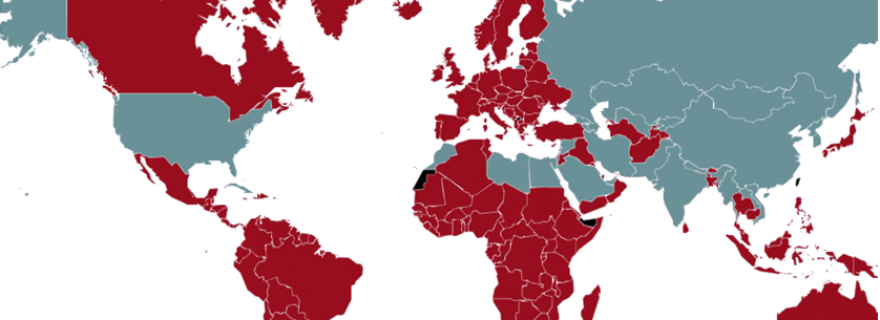The Ottawa Treaty on Landmines: Time for Rejuvenation
The Mine Ban Convention is weakened due to the development of new types of mines and assymetric conflicts. It is time to revise the treaty to make it fit for the 21st century.
The Ottawa Treaty, established in 1997 and often referred to as the Mine Ban Convention, is gradually being watered-down by the development of ‘smart mines’, asymmetric conflicts, and short-sighted behaviors of signatories and non-signatories. It is time to revise the treaty to make it fit for the 21st century.
New types of ‘smart mines’ are being developed by signatories and non-signatories of the Ottawa Treaty. For example, in 2014, the United States (US) government announced a new US landmine policy. The objective of that policy is to ban the production and acquisition of antipersonnel mines (outside the Korean Peninsula), increase research on alternatives by simultaneously complying with the Mine Ban Convention. The newly developed GATOR MINE SYSTEM, which is a network-based (the systems consists of more than 100 mines), automated weapons system is the first glimpse on new landmines that are not restricted by the Ottawa Treaty.
Finland, which ratified the Mine Ban Convention in 2011, is also to develop a type of ‘smart mine’ called bouncing landmine. By doing so, Finland hopes to deter its enemies, and to replace older ‘dumb’ mines at its 1340km long border with Russia. The bouncing landmine bounces in the air and launches projectiles on its targets downwards. It is, just as the Gator mine system, remotely activated by an operator with direct visual contact. This feature would enable the US and Finland to produce and utilize the mines without restraining requirements from the Ottawa Treaty because they are not defined as “anti-personnel” mines in the treaty.
According to article 2 of section 1 of the Ottawa Treaty, an “Anti-personnel mine [is] a mine designed to be exploded by the presence, proximity or contact of a person and will incapacitate, injure or kill one or more persons.” This means that newly developed ‘smart mines’ are not defined as anti-personnel mines under the Mine Ban Convention - since they are not triggered by persons but by a remote operator. Those ammunitions are no new phenomena: they were defined by Michael C. Horrowitz (2016) as weapons system that have a human in the loop who can observe, orient, decide and act according to existing rules and regulations. Lethal drones, for example, are utilized in the same way, leading to the killing or maiming of countless civilians, even outside assigned combat zones.
However, the main issue is not whether a human triggers a weapon or not. It is that an operator on the ground, with direct or distant visual contact (using in the latter case satellite images in a drone-control-center), can often not differentiate if approaching persons are enemies or not. This factor is especially worrisome in asymmetric warfare where fighters of inferior conflict parties often disguise their identity and intentions in order to avoid open battles with superior opponents.
Additionally, combatants and non-combatants are not fighting around the clock. In Syria for example, Islamic State fighters founded families and conducted daily-life activities with their loved ones, even in areas where battles took place. Thus, even, if operators identify an insurgent or terrorist, it is not always justified to pull the trigger. The Ottawa Treaty has a deficiency in that regard by not providing clear rules for a proportionate and necessary utilization of landmines.
Another indication that the Mine Ban Convention is not efficient anymore is the spiking numbers of casualties due to landmine-proliferation. Although 164 states signed the convention, 9437 people were officially killed or injured by landmines in 2016 – the highest number of casualties since 1999. A reason for the increase is the utilization of already forbidden types of landmines by insurgencies, terrorist groups, countries, and other parties. Furthermore, non-signatories to the Mine Ban Convention, like Russia, India, Iran, China, Saudi Arabia, and the US, are distributing or selling their conventional ‘dumb’ landmines as commodities to proxies and customers that are involved in several conflicts, for example in Yemen, Ukraine, Azerbaijan, Syria and Afghanistan.
The question is how the Ottawa Treaty can be strengthened to deal with new types of landmines, new conflicts, and short-sighted behavior of members and non-members. This could be done by increasing the (geo-) political pressure on these countries, introducing new sections or articles about ‘smart mines’, establishing monitoring mechanisms, and if necessary sanctions. So far, the Ottawa Treaty is too static, and, consequently, needs to be restructured as a flexible, living instrument that can be adjusted to technological, military, and political developments. Therefore, the Mine Ban Convention needs to be revised to fulfill its intended purpose, which is to protect humans (both soldiers and civilians), and to restrict the utilization of ‘anti-personnel landmines’ Otherwise, a successful instrument to deter landmine-proliferation will become obsolete. We should not let that happen.


